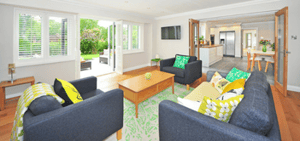 There's no place like home. There's no place like home. There’s no place like home. You can probably envision that classic scene from the Wizard of Oz where Dorothy closes her eyes, clicks her heels together and repeats the line until she’s wakes up in her bed at her farmhouse in Kansas with Auntie Em by her side. She’s relieved to be back at home – a familiar, comfortable place close to family and friends.
There's no place like home. There's no place like home. There’s no place like home. You can probably envision that classic scene from the Wizard of Oz where Dorothy closes her eyes, clicks her heels together and repeats the line until she’s wakes up in her bed at her farmhouse in Kansas with Auntie Em by her side. She’s relieved to be back at home – a familiar, comfortable place close to family and friends.
While Dorothy was a young woman, she’s not alone in her desire to live at home. Nearly 90 percent of people over age 65 want to stay in their home for as long as possible, and four out of five think their current residence is where they will always live. However, it’s estimated only 1 percent of U.S. households are conducive to aging in place.
According to the Joint Center for Housing Studies of Harvard University, here are the top five design features of an accessible home:
- No-step entry – A stairless threshold allows for easy access into the home, especially if someone uses a wheelchair or has difficulty walking. It’s also helpful if medical equipment needs to be brought into the home.
- Single-floor living – More than 30 percent of seniors have difficulty walking and using stairs. It’s easier to navigate a home when all the amenities (bedroom, bathroom, kitchen and living area) are on one level, such as a ranch-style home.
- Extra-wide hallways and doorways – Wheelchairs need more space to maneuver through passages and turn corners. The Americans with Disabilities Act (ADA) says door openings must be at least 32 inches wide and hallways a minimum of 36 inches wide to be accessible. Other organizations recommend larger openings (doorways at least 34 inches wide and hallways with a minimum width of 42 inches).
- Electrical controls reachable from a wheelchair – Light switches and electrical outlets should be mounted 15-48 inches above the floor. Rocker, toggle and touch sensitive switches are the easiest to use because they don’t require a lot of force, gripping or twisting.
- Lever-style handles on faucets and doors – Smooth, round knobs are difficult use because they require gripping, turning and sometimes pushing – often at the same time. Levers don’t require grasping or a lot of force.
There are also smaller projects you can do – such as removing throw rugs or adding more lighting – that can make a home safer for seniors. For more ideas, download our infographic: Reduce Fall Risks at Home.
In addition, many ComForCare/At Your Side Home Care offices offer home safety checks and fall risk assessments. Call 800-886-4044 to see if you or a loved one qualifies.
Additional resources:
Universal Design Toolkit for Home Owners
Institute for Human Centered Design – Universal Design in Housing
![Duel-Logo-CFC-AYS[rgb]](https://blog.comforcare.com/hs-fs/hubfs/Duel-Logo-CFC-AYS%5Brgb%5D.jpg?width=525&name=Duel-Logo-CFC-AYS%5Brgb%5D.jpg)
